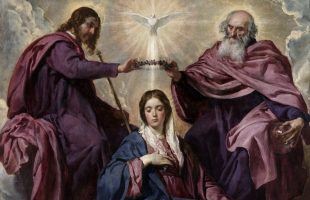
Lesson Objectives
- To see how Mary’s visit to Elizabeth parallels David’s bringing of the Ark of the Covenant to Jerusalem.
- To understand how the book of Revelation uses the startling image of the rediscovered Ark of the Covenant to introduce a vision of the Mother of Christ.
- To understand why the New Testament writers see Mary as the Ark of the New Covenant.
III. The Visitation
A. Elizabeth and Mary
The news that she would have a child was astonishing enough for Mary. But the angel Gabriel had more good news for her:
“And behold, Elizabeth, your relative, has also conceived a son in her old age, and this is the sixth month for her who was called barren; for nothing will be impossible for God” (see Luke 1:36-37).
Elizabeth and her husband Zechariah were both very old (see Luke 1:7); her pregnancy was nothing short of a miracle, though not a miracle on the same order as the one Mary was about to be a part of.
After this news, the very next thing we read is that Mary decided to visit her cousin Elizabeth.
We’re going to take a close look at this visit, because Luke will use it to show us a very important truth about Mary.
B. David’s Journey and Mary’s Visit
“In those days Mary arose and went with haste into the hill country, to a city of Judah, and she entered the house of Zechariah and greeted Elizabeth” (Luke 1:39-40, Revised Standard Version; compare the New American Bible translation).
We remember how “David arose and went” to a city of Judah to bring out the Ark of the Covenant (2 Samuel 6:2, Revised Standard Version; compare the New American Bibletranslation).
“When Elizabeth heard Mary’s greeting, the infant leaped in her womb” (see Luke 1:41).
In the same way, David “leaped and danced” before the Ark of the Covenant (see 2 Samuel 6:14-16).
When she felt her child leap in her womb, Luke tells us, Elizabeth was “filled with the Holy Spirit” (see Luke 1:41). “And how does this happen to me,” she asked, “that the mother of my Lord should come to me?” (see Luke 1:43).
Her words almost repeat what David said about the Ark of the Covenant: “How can the ark of the LORD come to me?” (see 2 Samuel 6:9).
Finally, after her glorious hymn of praise to God (which we know, from its first word in Latin, as the Magnificat; see Luke 1:46-55), “Mary remained with her [Elizabeth] about three months and then returned to her home” (see Luke 1:56).
The Ark of the Covenant “remained in the house of Obed-edom the Gittite for three months” on its way to Jerusalem (see 2 Samuel 6:11).
Luke piles these parallels one on top of another, so that we can’t help noticing the similarity between the Ark of the Covenant’s trip to Jerusalem and Mary’s trip to Zechariah’s house.
To drive the point home even more, Luke makes an interesting word choice in Luke 1:42: he tells us that Elizabeth “cried out in a loud voice” when she expressed her joy at Mary’s arrival.
The word translated “cried out” occurs nowhere else in the New Testament. But it does occur five times in the Greek translation of the Old Testament, and every time it shows up in passages having to do with the Ark of the Covenant, describing the joyful noise God’s people made in celebration of His presence among them.
Elizabeth lifts up her voice in praise of God in the presence of Mary, just as her ancestors (Elizabeth was a Levite and a descendant of Aaron the priest; see Luke 1:5) did in the presence of the Ark of the Covenant.
All these parallels point to one startling truth: Mary is the Ark of the New Covenant.
In the Old Testament, the Ark of the Covenant bore the tablets of God’s covenant, God’s word in stone. In the New Testament, Mary carries God’s Word in flesh, Jesus Christ, who will bring the New Covenant that Jeremiah foresaw so long ago (see Jeremiah 31:27-34)
Other Lessons
- Lesson One: A Biblical Introduction to Mary
- To understand the basic outlines of the New Testament’s witness to Mary.
- To appreciate how the Old Testament forms the essential background for what the New Testament teaches about Mary.
- To understand “typology” and its importance for reading the New Testament texts concerning Mary.
- Lesson Two: Wedding at Cana, Garden in Eden
- To appreciate the Old Testament symbolism that forms the deep background to the Gospel account of the wedding feast at Cana.
- To understand how Mary is depicted as a “New Eve” in this account.
- To appreciate the importance of the Old Testament marriage symbolism for John’s recounting of the “sign” at Cana.
- Lesson Four: Mother Crowned in Glory
- To see the importance of the Queen Mother in the Davidic kingdom of the Old Testament.
- To understand the duties and privileges that came with the position of Queen Mother.
- To see how Mary fills the position of Queen Mother in the kingdom of Christ.
- Lesson Five: The All-Holy Mother of God
- To understand the relationship between Catholic teaching about Mary and the Scriptural portrayal of Mary.
- To understand the biblical foundations of the Dogma of the Immaculate Conception.
- To appreciate how Catholic belief in the Immaculate Conception flows from the New Testament portrait of Mary as the “New Eve”
- Lesson Six: The Queen Assumed into Heaven
- To understand the biblical foundations of the Dogma of the Assumption.
- To understand the deep Old Testament symbolism and imagery in Revelation 12, and its relation to Catholic beliefs about Mary.
- To appreciate how the biblical portrait of Mary is reflected and interpreted in the Church’s liturgy.